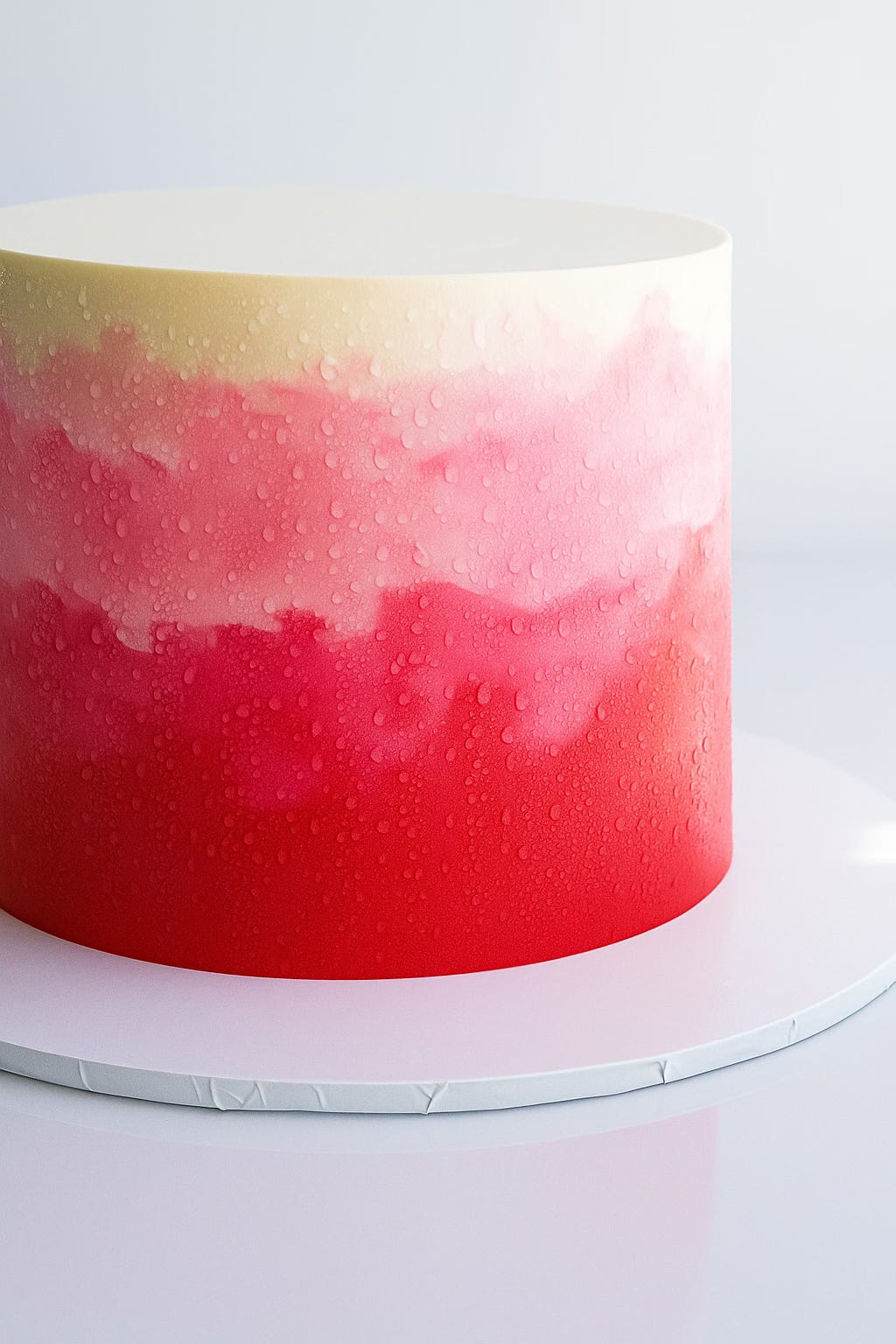If you’ve ever pulled a perfectly iced cake out of the fridge only to watch it turn slick and shiny in minutes, you’ve met the dreaded buttercream condensation 😅.
It’s one of the most common and frustrating problems cake makers face. But it doesn’t have to send you into a panic. Let’s break down why it happens and how to handle it like a pro.
Image credit: I couldn’t find a clear pic of a sweating cake so I got ChatGPT to edit the condensation onto a cake of mine 😆.
1. What Causes Condensation?
Condensation occurs when warm air hits a cold surface.
When moisture-packed warm air comes into contact with a chilly surface, it cools down quickly and releases the moisture, which turns into liquid droplets on the cold surface.
If you ever experienced winter where you are, you most likely have seen droplets of water on your window pane when you’ve got the heater going inside.
Vice versa, if you’ve experienced summer, then you would have also seen droplets of water on your window pane when you’ve got the air conditioning going inside.
So understand that condensation is a natural occurrence, it’s unavoidable when warm air hits a cold surface.
When it comes to cake making, this usually happens in summer, especially on really humid days. When you remove a cake from the fridge, which is nice and cold and bring it into your room environment, which is humid and not as cold, the warm, moisture packed air hits the cold surface on the cake and – bam! – condensation.
Now, the more humid the air, the more condensation there’ll be.
Now that we’ve established that condensation CANNOT be stopped, let’s look at how we can cope with it.
2. How to Combat Condensation:
👉 Reduce the moisture in the air.
When we think of moisture in the air, most of us think of naturally occurring humidity. Some days, the humidity is going to be higher. So, with a quick glance at the weather, it’s easy to tell how much humidity to expect your cake to be exposed to.
However, we tend to forget that we, too, contribute to the humidity of our living/working environment. On average, a family of four will create 100 pints (56 litres) of water vapour per week just through our daily domestic activities. Everything from showering, boiling kettles, running a bath, and even using a tumble dryer will add to the moisture in the air. The easiest way we can reduce moisture is to simply open a window. Opening a window allows fresh air to cycle through your house which is not only good for your cakes, but good for your health and your home’s feng shui as well
When that’s not enough, and you have a more serious humidity problem, consider a dehumidifier. We’re familiar with humidifiers, which inject moist air into your environment. A dehumidifier does the opposite. It removes the moisture from the air in your environment. You can get different sizes depending on the size of the space you want to filter.
👉 Reduce the temperature difference.
Now that we know that condensation occurs when moisture-packed warm air hits a cold surface, we want to try and reduce that temperature difference between the two elements.
When it comes to buttercream cakes, which always need to be stored in the fridge, the cold surface element cannot be mitigated. So, we have to manipulate the temperature of the air.
In winter, even though it’s super freezing outside, if you’re working with cakes, try not to have the heater on full blast in the house.
Vice versa, in summer, if it’s super hot outside, crank up the air con. You want the temperature of the air to be as far from ‘warm’ as possible.
Of course, I’m not asking you to reduce the temperature in your home or venue to 4°C like a fridge would be set to. But, if your work environment is 30°C, that’s pretty warm for a cake. Try lowering it to 18-20°C and there will be significantly less of a temperature shock when your cake leaves the fridge.
👉 If it’s out of your control, accept it.
Now, if you’ve reduced the moisture, controlled the temperatures and condensation still happens, there’s nothing left to do but to accept it. I used to freak out over condensation too but most of the time (if not all of the time), no one else noticed but me.
No one else but you, the cake maker, examines the cake on such an intimate level to notice a few drops of condensation or even a shinier sheen than normal. Unless your cake looks like it’s just been in the steam room, in which case you may want to give it a gentle pat with a sheet of paper towel. Otherwise, the bottom line is, if it’s out of your control, accept it and move on.
Condensation is inevitable when cold meets warm but, now you’ve got the tools to minimise its impact. In the next post, we’ll tackle another buttercream nightmare: melting. Stay tuned!
Let’s Talk 💬
Is there another scenario where you’ve experienced condensation on your cake which I didn’t cover in my article? If so, let me know in the comments and I’ll give you more insights 👇🥰.



